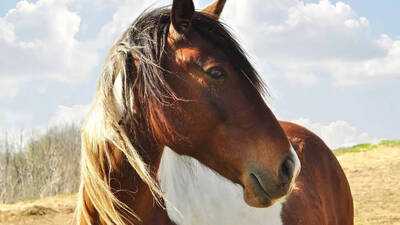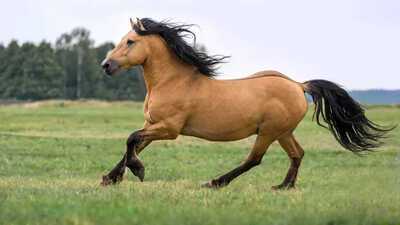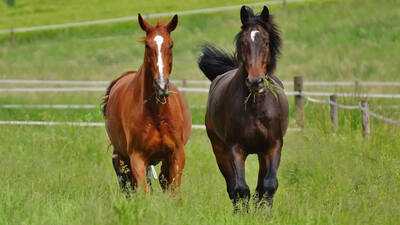How horses can tell when you're happy or sad by reading your facial expressions
Horses are not only elegant and intelligent animals but also surprisingly sensitive to human emotions. Research published in ScienceDirect shows that they can recognise feelings such as joy and sadness by reading facial expressions, revealing a remarkable ability to connect with humans on an emotional level. This skill is more than just intriguing; it has practical significance for interactions in riding, therapy, and everyday care. By understanding how horses perceive human emotions, trainers, caregivers, and enthusiasts can foster safer, more empathetic, and more effective communication with these animals. Studies using controlled experiments, including touchscreen-based tests, have demonstrated that horses can learn to distinguish between different emotions and even generalise this knowledge to unfamiliar faces, highlighting their advanced social cognition and reinforcing the importance of recognising their emotional intelligence in human-animal relationships.

How researchers studied horses’ emotional recognition

Scientists used a touchscreen-based device to test horses’ ability to identify human emotions. The device displayed pairs of human faces showing different expressions, such as joy, sadness, anger, fear, surprise, and disgust. When a horse touched the face showing the targeted emotion, it received a small food reward. This automated system ensured that the horses’ choices were based solely on the facial expressions themselves, rather than subtle cues from humans, providing more reliable results.
In the study, eleven horses were divided into two groups: one trained to touch the joyful face, the other trained to select the sad face. After several training sessions, the horses were tested with new faces they had never seen before to determine whether they could generalize their learning and accurately recognise the targeted emotions in unfamiliar humans, demonstrating true emotional recognition.
Horses understand human emotions: how they recognize joy and sadness

At the group level, both sets of horses learned to select the correct emotional face significantly better than random chance. Horses trained to recognise joy were able to generalise this knowledge to new faces, indicating that they had learnt a general concept of “joyful” expressions. Horses trained to identify sadness performed well during training but struggled to generalise to new faces, suggesting they may have memorised specific examples rather than the overall concept of sadness.
The study also found that horses’ performance varied depending on the other emotions shown alongside the target face. For example, distinguishing sadness from fear was more challenging than distinguishing sadness from joy or surprise. These results highlight that horses do not just react randomly; they use perceptual cues and the emotional valence (positive or negative nature) of facial expressions to make decisions.
Building better bonds with horses through emotions
These findings suggest that horses are highly attuned to human emotional cues. Recognising joy or sadness in humans may help horses respond appropriately in social situations, such as avoiding stressed or angry individuals or seeking comfort from a calm, happy person. This emotional sensitivity can enhance training, riding, and therapy programmes by allowing humans to communicate more effectively with horses through facial expressions.
Moreover, understanding horses’ emotional perception underscores the importance of treating them as sentient beings with social and cognitive awareness. By acknowledging their capacity to interpret human emotions, owners and trainers can build stronger, safer, and more empathetic relationships with these animals.
This research adds to a growing body of evidence that horses possess sophisticated social cognition. Beyond recognising basic emotions, horses can remember individual humans and respond differently based on past interactions. Studies like this one help reveal the depth of horses’ emotional intelligence and highlight the complex ways animals and humans can understand each other. Horses are capable of perceiving human joy and sadness and can even generalise this understanding to new faces. These insights not only deepen our appreciation for horses’ intelligence but also offer practical applications for improving human-animal relationships in everyday life.
Also Read: Meet the massive giant Pacific octopus that grows nearly 10 metres and hunts at night
How researchers studied horses’ emotional recognition
Scientists used a touchscreen-based device to test horses’ ability to identify human emotions. The device displayed pairs of human faces showing different expressions, such as joy, sadness, anger, fear, surprise, and disgust. When a horse touched the face showing the targeted emotion, it received a small food reward. This automated system ensured that the horses’ choices were based solely on the facial expressions themselves, rather than subtle cues from humans, providing more reliable results.
In the study, eleven horses were divided into two groups: one trained to touch the joyful face, the other trained to select the sad face. After several training sessions, the horses were tested with new faces they had never seen before to determine whether they could generalize their learning and accurately recognise the targeted emotions in unfamiliar humans, demonstrating true emotional recognition.
Horses understand human emotions: how they recognize joy and sadness
At the group level, both sets of horses learned to select the correct emotional face significantly better than random chance. Horses trained to recognise joy were able to generalise this knowledge to new faces, indicating that they had learnt a general concept of “joyful” expressions. Horses trained to identify sadness performed well during training but struggled to generalise to new faces, suggesting they may have memorised specific examples rather than the overall concept of sadness.
The study also found that horses’ performance varied depending on the other emotions shown alongside the target face. For example, distinguishing sadness from fear was more challenging than distinguishing sadness from joy or surprise. These results highlight that horses do not just react randomly; they use perceptual cues and the emotional valence (positive or negative nature) of facial expressions to make decisions.
Building better bonds with horses through emotions
These findings suggest that horses are highly attuned to human emotional cues. Recognising joy or sadness in humans may help horses respond appropriately in social situations, such as avoiding stressed or angry individuals or seeking comfort from a calm, happy person. This emotional sensitivity can enhance training, riding, and therapy programmes by allowing humans to communicate more effectively with horses through facial expressions.
Moreover, understanding horses’ emotional perception underscores the importance of treating them as sentient beings with social and cognitive awareness. By acknowledging their capacity to interpret human emotions, owners and trainers can build stronger, safer, and more empathetic relationships with these animals.
This research adds to a growing body of evidence that horses possess sophisticated social cognition. Beyond recognising basic emotions, horses can remember individual humans and respond differently based on past interactions. Studies like this one help reveal the depth of horses’ emotional intelligence and highlight the complex ways animals and humans can understand each other. Horses are capable of perceiving human joy and sadness and can even generalise this understanding to new faces. These insights not only deepen our appreciation for horses’ intelligence but also offer practical applications for improving human-animal relationships in everyday life.
Also Read: Meet the massive giant Pacific octopus that grows nearly 10 metres and hunts at night
Next Story